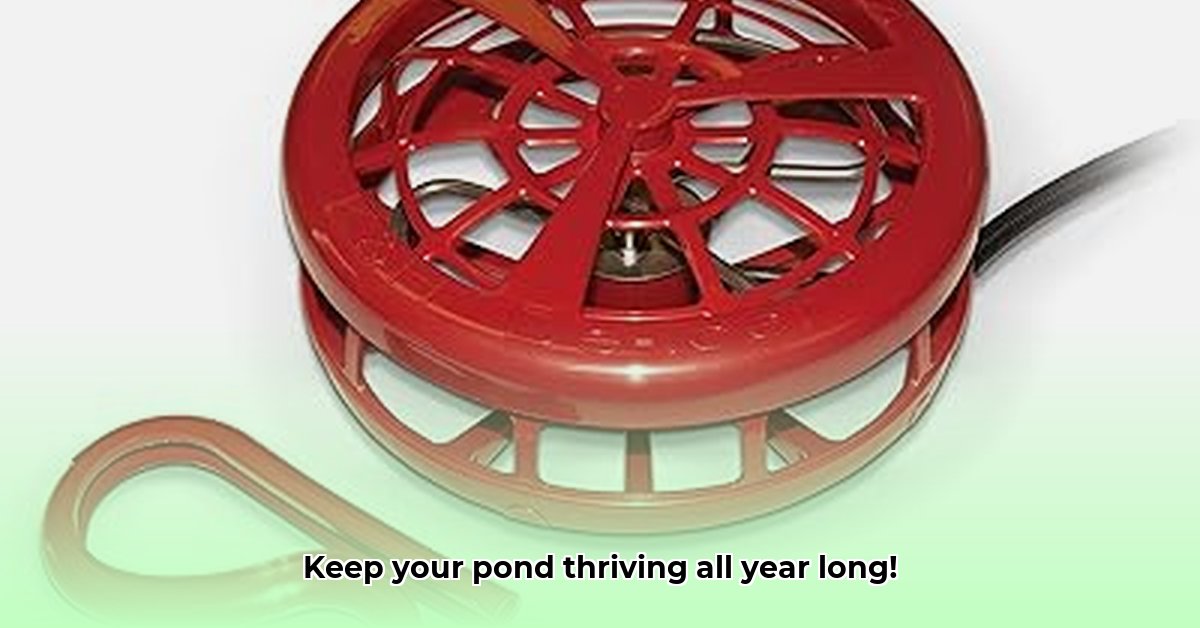
Choosing the Right Pond Heater: A Tailored Approach for Sustainable Agriculture
Your farm pond is a valuable asset, supporting fish, plants, and potentially even irrigation. Maintaining optimal water temperature year-round is crucial for productivity and ecosystem health. A well-chosen pond heater from Tractor Supply can be a key investment in your farm's sustainability. But how do you choose the right one? For additional heating options, check out other heaters.
Pond Size and Climate: The first step is assessing your pond's size and your local climate. Larger ponds need more powerful heaters to maintain temperature. Harsh winters demand higher wattage to prevent freezing. Tractor Supply's website and knowledgeable staff can guide you in selecting the appropriate wattage based on your pond's volume and your region's climate. Don't underestimate the impact of cold snaps – insufficient heating can lead to devastating winterkill.
Energy Efficiency: A Crucial Factor: Energy-efficient heaters are kinder to your wallet and the environment. Look for models with high energy efficiency ratings (like Energy Star) to minimize your operational costs and carbon footprint. While the initial cost may be higher, the long-term savings in electricity bills make the investment worthwhile.
Types of Pond Heaters and Sustainability: Tractor Supply offers various pond heaters, each with its own energy efficiency profile:
| Feature | Submersible Heater | De-icer/Surface Heater | Solar-Powered Heater (if available) |
|---|---|---|---|
| Energy Source | Electricity | Electricity | Solar Energy |
| Wattage Range | Typically Higher | Typically Lower | Varies depending on panel size |
| Installation | Submerged | Surface | Requires suitable sun exposure |
| Initial Cost | Generally Higher | Generally Lower | Can be higher initially, lower long-term |
| Maintenance | Requires Occasional Cleaning | Minimal Maintenance | Minimal maintenance, panel cleaning |
| Sustainability Rating | Moderate (energy source dependent) | Moderate (energy source dependent) | High |
Note: The sustainability rating is a relative comparison and depends on the specific model and its energy source. Solar-powered options, when feasible, offer the highest sustainability rating.
Installing Your Pond Heater: A Step-by-Step Guide for Optimal Performance
Safe and effective installation is critical. Follow these numbered steps:
Safety First: Always disconnect the power supply before starting any work. This prevents dangerous electrical shocks.
Strategic Placement: Position the heater for even heat distribution. Avoid placing it directly under plants or near sensitive areas. Consult your heater's instructions for optimal placement – submersible heaters require careful submersion to the correct depth.
Secure Mounting (if needed): Use the provided anchors or weights to securely fix the heater in place, preventing movement and potential damage.
Electrical Connection: Once correctly positioned, connect the heater to a GFCI (Ground Fault Circuit Interrupter)-protected outlet. GFCI protection is essential, significantly reducing the risk of electrical shock.
Post-Installation Check: After connecting the power, verify the heater is functioning correctly and the water temperature is gradually increasing.
Maintaining Your Pond Heater: Extending Lifespan and Efficiency
Regular maintenance is essential for your heater's longevity and performance:
Monthly Inspections: Inspect the heater monthly for any signs of damage (cracks, corrosion, loose wires). Early detection prevents major problems.
Annual Cleaning: Clean the heater at least once a year using a soft brush and non-abrasive cleaner to remove algae and debris. This improves efficiency and prevents buildup.
Winter Storage (if applicable): Properly store the heater during winter months, following the manufacturer’s instructions to avoid freezing damage.
The Broader Picture: Pond Heaters and Sustainable Farm Practices
Investing in a pond heater offers substantial benefits beyond simply preventing winterkill:
Protecting Biodiversity: Maintaining consistent water temperature protects fish and aquatic plants from frost damage, preserving your pond's biodiversity. A healthy pond ecosystem contributes to overall farm health.
Year-Round Productivity: A warmer pond allows for extended growing seasons for aquatic plants and potentially improved fish production, maximizing your farm's productivity.
Enhanced Water Quality: By preventing winterkill, pond heaters indirectly contribute to better water quality, reducing the need for chemical treatments.
Improved Irrigation: In some cases, a healthy, consistently-warmed pond can improve the quality of water for irrigation, further boosting your farm's efficiency.
Dr. Emily Carter, Agricultural Engineer, University of California, Davis: "Sustainable agriculture requires holistic thinking. Investing in energy-efficient pond heaters is a smart strategy, balancing productivity with environmental responsibility."
Building a Cost-Effective and Sustainable Farm Pond: A Holistic Approach
Careful planning is essential for a truly sustainable farm pond. Choosing native plants and fish reduces the need for extra care. Natural filtration methods, like using aquatic plants, cuts down on the need for chemical treatments and energy costs. Regular maintenance, including monitoring water quality and managing plant growth, is crucial for long-term health, maximizing your investment.
Key Takeaways:
- A well-planned pond, incorporating natural filtration and native species, reduces long-term maintenance costs.
- Energy-efficient pond heaters from Tractor Supply are a smart investment, protecting your aquatic ecosystem and boosting year-round productivity.
- Regular maintenance is crucial for long-term pond health and cost-effectiveness.
By combining these elements, you can build a thriving, sustainable farm pond that benefits your operation for years to come. Remember to consult with Tractor Supply experts for personalized advice and support in choosing and maintaining your pond heater. A healthy pond is a productive pond, and a productive pond is a sustainable farm.